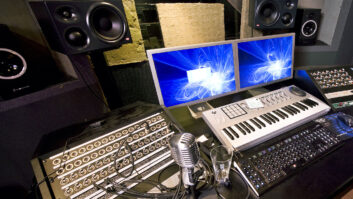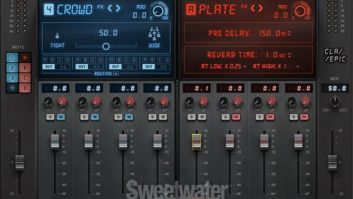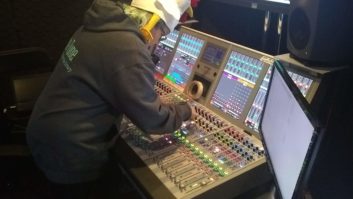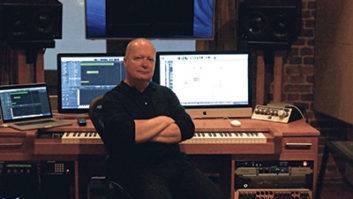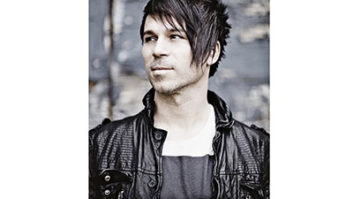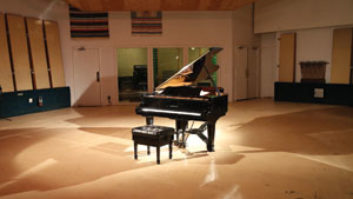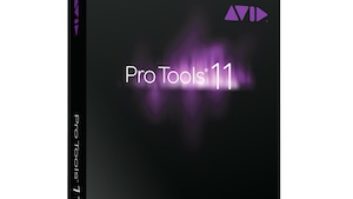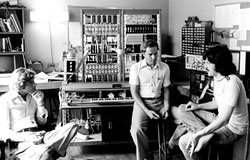
Early days in the Fairlight R&D lab with (L-R) John Lancken, Peter Vogel and (a barefoot) Kim Ryrie
Maybe it stems from its Australian roots, but during the past 30 years, Fairlight has always forged its own path as a technology leader.
The company was founded in December 1975 by electronics designer Kim Ryrie and his boyhood friend, Peter Vogel. Frustrated by the limitations of analog synthesis, they were interested in using the newly available microprocessors to create digitally controlled synthesizers. After some months with little progress, the pair met Tony Furse, who had developed a light pen — controlled digital synth using dual 8-bit pathways and Motorola 6800 chips. Combining Furse’s technology with their digital synthesis approach resulted in the Qasar M8, a bulky 8-voice system that didn’t sound very good and went nowhere.
Back to the drawing board, Ryrie and Vogel developed the CMI (Computer Musical Instrument). The CMI was based on two 6800 processors and provided digital synthesis with a 6-octave keyboard, 8-note polyphony, two 8-inch floppy disk drives (one for the operating system, the other for archiving/library storage of sounds) and a whopping 208 KB of RAM. The system offered onscreen displays of waveforms, which could be modified via Fourier synthesis or simple light pen redrawing of the waveform. The CMI also offered sampling, with the ability to pitch-shift sounds or make modifications via the CMI processor. An onboard sequencer stored note velocity information, and up to eight 8-bit audio outs were available for routing to a mixer or multitrack. Unlike the Qasar M8, the CMI sounded great and was way ahead of its time. It was officially launched in 1979, with the first two units going to Peter Gabriel and Stevie Wonder.
The CMI (and its later generations) garnered worldwide acclaim and expanded its capabilities with higher-resolution sampling, advanced sequencing and SMPTE sync. “My first experience with a Fairlight was in 1978 as a student when the Sydney Conservatory of Music bought CMI serial number 2,” recalls current Fairlight COO John Lancken. “I watched the company rise in prominence, especially through the ’80s, when early adopters like Peter Gabriel, Stevie Wonder, Herbie Hancock and others got involved with the company. It was also popular live, even though it was mainly a large computer instrument.”

Fairlight COO John Lancken, today
But with the advent of MIDI and a slew of low-cost samplers in the ’80s, the luster of a full-blown $150,000 Fairlight music system began to fade and the company looked to new markets. “I joined the company — for the first time [Lancken left Fairlight in 2001] — in 1991 as it was moving away from music and into disk recording/editing for post-production with the MFX Series,” Lancken says. “The company succeeded with that for the next 10 years. Our first business in Hollywood was with Todd-AO and the company grew substantially.”
In the early 2000s, commercial pressures and other world events reduced the pack of DAW manufacturers from more than 25 to a handful, forcing Fairlight through a series of difficult years. Events turned sour in April 2003, when Fairlight was forced into receivership. “The problems the company faced had nothing to do with the quality of products but with management — overestimating the returns of the market and building a structure that was unsustainable, poor cash flow, et cetera,” says Lancken. Just a few months later, he returned to assume leadership of the once-troubled company, but this time under the new name Fairlight.au (the “au” is for Australia), with new financing and a renewed commitment to meet the needs of the worldwide commercial audio production marketplace.
“Audio people aren’t always the best business people,” Lancken says. “The turnaround in 2003 came from finding a formula that worked with the business.” However, the new Fairlight wasn’t simply a case of throwing money at a problem. The company had a series of cutting-edge products that put Fairlight back into a leadership role. Powered by its QDC platform and the innovative Binnacle control of the DREAM Series interfaces, Fairlight launched the Fairlight StationPlus and the DREAM Constellation large-format digital console, which included high-end automation; an integrated suite of low-latency, third-party plug-ins; nonlinear video; and an integrated 96-track DAW. Just a year ago, these were followed by the Constellation XT, which brought a new price/performance category to large-format digital consoles.
Another key factor in the turnaround? “The heart of the company is development and R&D, our biggest investment,” Lancken explains. “We’re putting something like 40 percent of our turnover back into R&D. We’ve launched five new products in the past two years, proving we can respond quickly to the market.”
So what’s on the horizon for Fairlight .au? “We have some great technology and intellectual properties,” he continues. “Technology moves at high speed and we can move with it. Over 30 years, Fairlight has invented things that no one else had, and there’s more coming, including The Anthem console, which we’re debuting at AES. It symbolizes a round trip for the company that’s gone from music into disk recording/editing and now back into music.”
